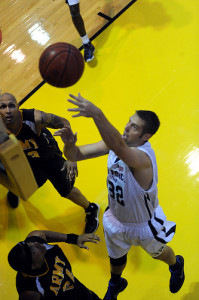5 Causes of a Low Team Shooting Percentage

At the end of a tight or loosing game, a coach will often reflect upon the statistics of a game and in particular a Team’s Shooting Percentage. This statistic alone often provides a wide range of points for discussion between coaching staff, team members, and the public alike. With good reason as many teams need to win or at least be in line with their opposition to reach a successful outcome at the end of a game with any ongoing consistency and improvement of form. Shooting Percentage along with Rebounding is one of the pillars of a successful team.
While there are teams that employ a “run and gun” mentality to their shooting, it is counter intuitive that wasteful shots in poor situations ultimately benefit a team. Even if a shooting a greater number of shots is in essence part of the team offensive strategy, there will still be an acceptable shooting percentage to be achieved.
Poor Individual Shot Selection
One of the more common reasons for a lower then acceptable shooting percentage is poor individual shot selection. Put simply this comes down to the wrong player taking a shot. This can be because a player sees an opportunity but lacks the skill to be able to complete the scoring movement or because the players is showing poor judgement about what is and isn’t a good shot for themselves and the team.
This situation really comes down to a coach’s analysis, assessment, communication, and development of a player. By having clearly define expectations and feedback back on a players competence a coach can frame more easily what is the right shot and when for a player in the team context.
Not Enough Fast Break and Primary Transition Points
Teams that struggle with a low shooting percentage often find they are heavily reliant on long shot clock possessions that focus continuously on the half-court offense phase. Depending on a team’s strategy this might the desired outcome, but this should not be at the expense of not exploring the Fast break and Primary Transition Phases of an offensive possession. Exploring all phases while being in control of the tempo and shot selection is the ultimately desired outcome, not just abandoning these phases completely.
This situation comes down to a coach providing a well-rounded training schedule that does develop all offensive phases. Too much focus on one element will of course devalue the other phases in the eyes of the players (even at the professional level).
Too Many Shots outside the Keyway
Depending on the statistics recorded it can be very easy to see where shots are being taken from on the floor. It seems very obvious, but the greater the distance away from the basket, the lower the team’s shooting percentage.
This can come down to players settling for the easier or less pressured shooting options. However, there are some other reasons that should be explored as well. A coach should ask themselves do the players understand what the shooting options are and where they are in the flow of the play? Is the offense not providing enough scoring opportunities within the keyway? What defence is causing this the offense to not be effective and why? These questions will help to explore some of the other possibilities for a poor shooting percentage.
No Dominate Floor General
Another often understated reason for a team’s poor shooting percentage is a the lack of Point Guard or dominate leader on the floor. This type of situation can result in the wrong play and wrong shoot being focused upon when the ball is on the floor. In extreme situations this mistake can be made in successive possessions and destroy a teams flow or ability to make to scoring opportunities reality in successive possessions throughout a game.
A coach will need to in these situations provide some extra guidance to the team while trying to build the knowledge, understanding, and confidence within the players showing the most potential to fulfil this role. Leadership in this context can be nurtured and it is the responsibility of the coach to provide as best as possible a platform for individuals within a team to acquire these skills.
Lack of Commitment to Improving Individual Shooting Percentage
The final common issue is a lack of commitment by players to improving their own shooting. This can either be improving the percentage at which a player currently shooting from within their range or increasing a players shooting range. In both instances, though this requires a player to put in time away from the team training session to improve their competence to meet the required standard of competition. This again can be all about the level of involvement a coach has in the individual player’s development within a team they are coaching. The higher the involvement of a coach the more the motivation will be easily found by players.
Shooting percentage is important and there is no getting around the fact it will have a significant effect on a game. By seeing, the possible causes for problems more readily a coach can better prepare a team against the challenges that lay ahead and at the very least form a plan under which to overcome these issues.



Leave a Reply